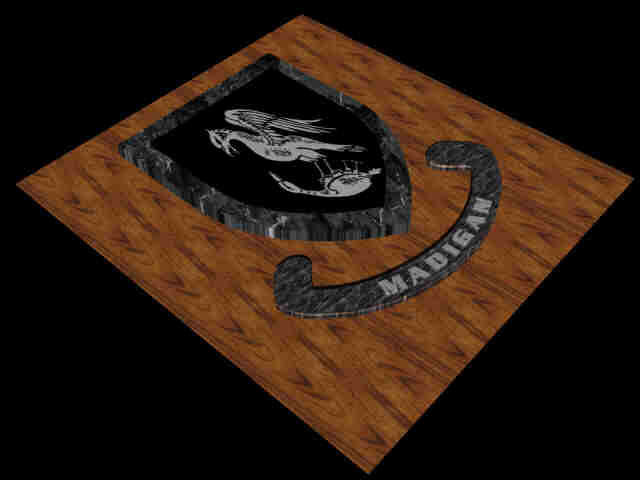They created the potlatch or gathering. It was held for a clan. A
potlatch can be held for many
 reasons: to celebrate a child's passage into adulthood or in memory of those who have died. In some areas of Alaska, special sticks are made and used only for the Memorial Potlatch. When a person hits the sticks together during song, he beats the pain from the mourner's hearts. When the potlatch is over, one or both of the sticks are destroyed signaling the end of grief. When a person decides to hold a potlatch, he or she prepares by gathering
gifts such as blankets, rifles, cloth and traditional Native foods like moose and salmon. It may take years for a person to accumulate all that is necessary. During the potlatch, the host feeds all the guests and celebrates with songs, speeches, dancing and
reasons: to celebrate a child's passage into adulthood or in memory of those who have died. In some areas of Alaska, special sticks are made and used only for the Memorial Potlatch. When a person hits the sticks together during song, he beats the pain from the mourner's hearts. When the potlatch is over, one or both of the sticks are destroyed signaling the end of grief. When a person decides to hold a potlatch, he or she prepares by gathering
gifts such as blankets, rifles, cloth and traditional Native foods like moose and salmon. It may take years for a person to accumulate all that is necessary. During the potlatch, the host feeds all the guests and celebrates with songs, speeches, dancing and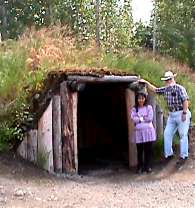 games. On the final day the
gifts are given away to thank the guest for bearing witness to the host's joy or sorrow and for the service they have rendered in the past.
The Aleut and Alutiiq people make up the tribe that exists along the Aleutian Islands. This is some of the harshest terrain in Alaska. There are virtually no trees. Life exists at the water's edge for it is the waters that supply almost all the food. In the 19th century, the Russians arrived and greatly influenced the Indians. The Greek Orthodox Church still plays an important part in their lives. Here the winters were so severe that families had to move
underground for protection. The winter dwellings were communal, large and covered with dirt and grass for insulation. They fashioned raincoats out of the stomach of sea mammals, sewn together with
stitching so fine, they were actually waterproof.
The land from Anchorage, in the south, to Nome, in the west, are inhabited by the Inupiaq and the St. Lawrence Island Yupik people. They were hunters and gatherers, subsisting on the sea and land resources of our region. Their lives revolved around whale, walrus, seal,
games. On the final day the
gifts are given away to thank the guest for bearing witness to the host's joy or sorrow and for the service they have rendered in the past.
The Aleut and Alutiiq people make up the tribe that exists along the Aleutian Islands. This is some of the harshest terrain in Alaska. There are virtually no trees. Life exists at the water's edge for it is the waters that supply almost all the food. In the 19th century, the Russians arrived and greatly influenced the Indians. The Greek Orthodox Church still plays an important part in their lives. Here the winters were so severe that families had to move
underground for protection. The winter dwellings were communal, large and covered with dirt and grass for insulation. They fashioned raincoats out of the stomach of sea mammals, sewn together with
stitching so fine, they were actually waterproof.
The land from Anchorage, in the south, to Nome, in the west, are inhabited by the Inupiaq and the St. Lawrence Island Yupik people. They were hunters and gatherers, subsisting on the sea and land resources of our region. Their lives revolved around whale, walrus, seal,
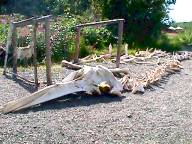 polar bear caribou and fish. The region is vast and seemingly uninhabitable to others, but the land and sea has been host to these unique groups of people since time immemorial. The weather and the land is
as harsh as any. Again these people move underground for the winter, later building summer dwellings for the short warm season. They practiced extended family living. Fishing and hunting were group affairs. Everything they needed came from the
land and sea. On display was a raincoat made out of seal intestine, along with other tools and instruments, which they had made. The Athabascans were nomadic, traveling in small groups to fish, hunt and
trap. They lived along the interior's waterways, following the seasonal resources. Traditionally, Athabascans are taught respect for all living things. An important part of the their subsistence is sharing. All hunters are part of a kin-based network in which they are expected to follow traditional customs for sharing. Their housing was temporary for the most part, having to pull up stakes and move with the flowing food source.
Their territory was made up of the better part of the Alaskan interior. As a result of their travels, they
built their shelters above ground, sometimes in the form of a log cabin, other times as a teepee with a rounded top.
The Cup'ik and Yup'k make up the final group or tribe. They settled along the coastal area of the Bearing Sea where they
polar bear caribou and fish. The region is vast and seemingly uninhabitable to others, but the land and sea has been host to these unique groups of people since time immemorial. The weather and the land is
as harsh as any. Again these people move underground for the winter, later building summer dwellings for the short warm season. They practiced extended family living. Fishing and hunting were group affairs. Everything they needed came from the
land and sea. On display was a raincoat made out of seal intestine, along with other tools and instruments, which they had made. The Athabascans were nomadic, traveling in small groups to fish, hunt and
trap. They lived along the interior's waterways, following the seasonal resources. Traditionally, Athabascans are taught respect for all living things. An important part of the their subsistence is sharing. All hunters are part of a kin-based network in which they are expected to follow traditional customs for sharing. Their housing was temporary for the most part, having to pull up stakes and move with the flowing food source.
Their territory was made up of the better part of the Alaskan interior. As a result of their travels, they
built their shelters above ground, sometimes in the form of a log cabin, other times as a teepee with a rounded top.
The Cup'ik and Yup'k make up the final group or tribe. They settled along the coastal area of the Bearing Sea where they
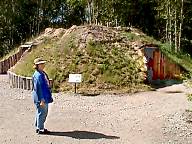 became fishermen and hunters of the foods produced by the sea. Again, underground bunker-like winter quarters were used, as well as summertime temporary camps. Here we found that the harsh winters, some of the worst in Alaska, had created a slightly different quartering arrangement. A mother and her married daughters, or several married sisters, lived in the women's house with their female children. They prepared food for their men and boys who worked and lived in the "qusgiq". Though women owned the houses, men built and maintained them and would visit their wives and mothers in the evenings. Like most other Alaskan Eskimo dwellings the
Yup'ik/Cup'ik women's house shared the same distinctive semi-subterranean winter entrance passageway which also provided space for cooking. In some cases the spring and summer entry was covered by flaps made of sealskin or woven grass. The "qasgiq" served both as the man's house and community
became fishermen and hunters of the foods produced by the sea. Again, underground bunker-like winter quarters were used, as well as summertime temporary camps. Here we found that the harsh winters, some of the worst in Alaska, had created a slightly different quartering arrangement. A mother and her married daughters, or several married sisters, lived in the women's house with their female children. They prepared food for their men and boys who worked and lived in the "qusgiq". Though women owned the houses, men built and maintained them and would visit their wives and mothers in the evenings. Like most other Alaskan Eskimo dwellings the
Yup'ik/Cup'ik women's house shared the same distinctive semi-subterranean winter entrance passageway which also provided space for cooking. In some cases the spring and summer entry was covered by flaps made of sealskin or woven grass. The "qasgiq" served both as the man's house and community
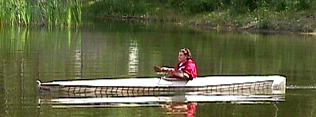 center. Boys old enough to leave their mothers joined male relatives in the qasgiq, where together they worked, ate, bathed and slept, and the older males taught the younger ones how to be Yup'ik/Cup'ik men. Mothers and wives brought them food, and joined in the evening singing, dancing and festive events. Twice as large as the winter houses in which women and girls lived the qasgiq nevertheless shared the same architectural features; a post and beam driftwood structure covered with grass and sod. Bearded seal or walrus intestines provided a removable skylight window. This was a great place for someone who has a strong interest in the details of the local Indians. It seemed to me to fall short of detail and material compared to some of the museums we went through in the southeast section.
center. Boys old enough to leave their mothers joined male relatives in the qasgiq, where together they worked, ate, bathed and slept, and the older males taught the younger ones how to be Yup'ik/Cup'ik men. Mothers and wives brought them food, and joined in the evening singing, dancing and festive events. Twice as large as the winter houses in which women and girls lived the qasgiq nevertheless shared the same architectural features; a post and beam driftwood structure covered with grass and sod. Bearded seal or walrus intestines provided a removable skylight window. This was a great place for someone who has a strong interest in the details of the local Indians. It seemed to me to fall short of detail and material compared to some of the museums we went through in the southeast section.
***THE END***

